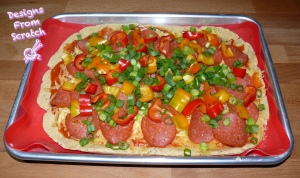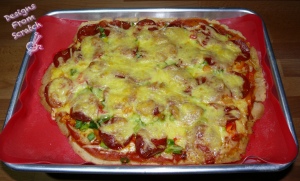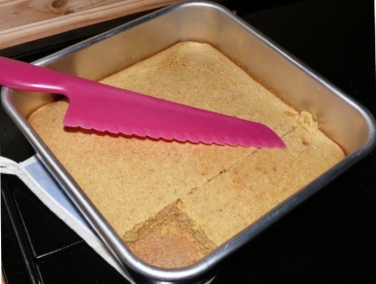Note: This post got a tad long…if you just want to hurry right on to the pizza-crust-making part I won’t be offended! There are some tips I found helpful along with the recipe. If you are brave enough to wade through the tales of all my trials and errors, you may just find something helpful 🙂 Either way, good luck and happy eating! I’d love to know how your crust turns out!!
If you’re like me then you LOVE pizza. If you’re really like me you then you’re probably here because you can’t eat gluten. Either way, gluten-free is definitely the way to go when it comes to delicious, homemade pizza! Think about it, how many times have you seen someone refuse to eat their crust? That’s because it’s just regular-old-pizza-crust. Try this gluten-free recipe and stop picky eaters in their tracks!
I’ve had pizza on the brain ever since I cut gluten and dairy out of my diet. Out of all the foods I can no longer eat, I’ve missed pizza the most. It turns out that my true problem is with gluten. I was honestly very relieved when I realized I didn’t have to give up dairy for good. I could go my whole life without eating another grain of wheat, but life without dairy? No way! Coffee just isn’t the same without milk, and I’m a huge fan of cheese and yogurt. I’ve been scheming up ways to make a gluten free pizza, but it’s been way too hot lately to bake. The other night it was finally cool enough to turn on the oven.
My husband was totally on board to make gluten-free pizza for dinner. After listening to me talk about pizza non-stop for months now, we were both excited! We’ve made tons of pizza over the years, and have perfected our crust recipe. We found that baking spices into the actual dough really adds a lot to the finished product. This was our first attempt at making a gluten free pizza though, so I wasn’t sure what to expect.
Our first attempt was a bit of a disaster. We used a mix of garbanzo bean and brown rice flours. Since we’d never tried/ worked with garbanzo bean flour, we decided not to use a lot of it. Even with the small bit of flour, it made the dough really gummy and hard to work with. We ended up adding more brown rice flour to even things out. The resulting dough still had a heavy garbanzo bean taste to it, so if that’s not your thing, you may not want to use garbanzo bean flour (unless in tiny amounts). I ended up putting half of the dough in the fridge and made it the next day. That batch surprisingly did not taste like garbanzo beans, so maybe that helped!
Since we were new to being gluten-free, I didn’t know to add starch to the pizza mix. We ended up making thin crust pizza dough, so this didn’t seem to be a problem. It was definitely very crispy though, so if you are looking for a softer crust (or something other than thin crust) then I would recommend using at least 1/3 part starch in your total flour ratio.
I have since perfected (in my very humble opinion!) my pizza crust and to be honest the exact flour mix I use is different every time based on what flours I have on hand. The basics, however, are always the same. I like to make it 2 parts flour and 1 part starch (so 1/3 cup of starch for every 2/3 cup of flour). In my experience, this has proved to be a good ratio for both texture and taste. I like to use a mixture of brown rice and sorghum flours along with a starch (usually potato or tapioca starch). A few table spoons of blue corn meal is also a good addition. No matter what you choose, I highly recommend using at least two types of gluten free flour with your starch. This will help keep one flavor from being too overpowering. It can also help with the texture of your crust, as some GF flours can be coarser or finer than others.
I also like to add spices such as basil, oregano, garlic, pepper, and onion powder to the flour mixture to give it some extra character. Fresh onion, spinach, and olive slices are also great additions when baked right into the dough. In the past we’ve even added pizza sauce when the dough felt a little dry.
This recipe produces two medium sized pizza crusts, and is enough to feed 4 to 6 people. It can easily be doubled – or more! I like to triple the recipe and make a bunch of mini pizza crusts to freeze and use later.
Once you bake the crust, don’t forget to load it up with pizza sauce and all of your favorite toppings! We love adding lots of vegetables and turkey pepperoni in this household 🙂
Gluten-Free Pizza Crust
1/2 c brown rice flour
1/2 c sorghum flour
1/2 c tapioca starch
OR
1 c gluten-free flour mix
1/2 c gluten-free starch
herbs & spices – to taste (optional)
1 pkg. instant yeast
1tbs sugar or 1tsp honey
2 tbs olive oil
1 c warm water
- Combine the flour, sugar and yeast together in a large mixing bowl. Add your favorite herbs and spices, such as, basil, oregano, garlic, and onion powder.
- Add the olive oil and warm water (this is where you add the honey if that’s what you are using instead of sugar. Mix the ingredients together until the dough is too stiff to stir with a utensil.
- Knead the dough by hand. If the dough is too dry, add pizza sauce 1 tablespoon at a time until it’s the right consistency. If the dough is too wet, gradually add flour.
- Divide the dough in half, cover, and let rise for 10 minutes. See baking instructions below.
Regular Pan-Crust Pizza
- Using two greased 9x9x2″ baking pans, press the dough into the bottom of the pans and 1″ up the sides for the crust. Cover the pans and let the dough rise until it’s doubled in size (approx. 35-45 minutes).
- Bake the crust at 375 degrees for about 25 minutes or until brown.
- Top with pizza sauce, cheese, and your favorite meats and vegetables.
- Bake for another 20 to 25 minutes at 375 degrees
Thin-Crust Pizza
- Roll the dough out onto two 12″ round pizza pans. Do not let them rise.
- Bake at 425 degrees for about 12 minutes or until golden brown.
- Add the pizza sauce and toppings while the crust is still hot.
- Bake at 425 degrees for about 12 minutes – 15 if you like it crispy.
Some basic pizza crust tips I have found helpful:
- Use at least two types of flour in addition to the starch. I know I have mentioned this, but I’m saying it again because it really makes all the difference! It can be hard to find/ keep multiple types of gluten free flour, but it it truly helpful. You can always freeze the flour to help it keep longer. Some of the flours I have used: brown rice, millet, sorghum, buckwheat, blue corn meal, garbanzo bean flour. I know there are others, but those are the ones that come to mind at the moment.
- Don’t be afraid to change up the ratio. This recipe is a basic guide, but everyone has different tastes. I have found that using a little bit more starch and less flour in your mix makes it easier to roll out.
- If your crust falls apart or is crumbly after baking, you may want to add some sort of binder to the dough next time. A little bit of xanthan gum or unflavored gelatin helps. I also like to use 1/2 Tbs of chia seeds mixed with 2 Tbs of hot water. Let this mixute sit for 5 mintues before adding it in with the wet ingredients. If you use the chia mixture in your crust be sure to use a little less water from the main recipe.
- Get creative! As I said, I like to add spices to my dough mix. The possiblities are endless. However, this crust kicks some serious booty without any help too 😀
Our gluten-free pizza was so good that my husband and I even thought about making it again for the third night in a row! Let me know how your crust turns out!


















You must be logged in to post a comment.